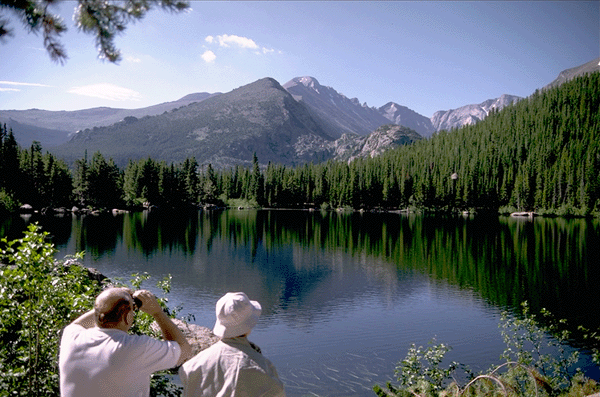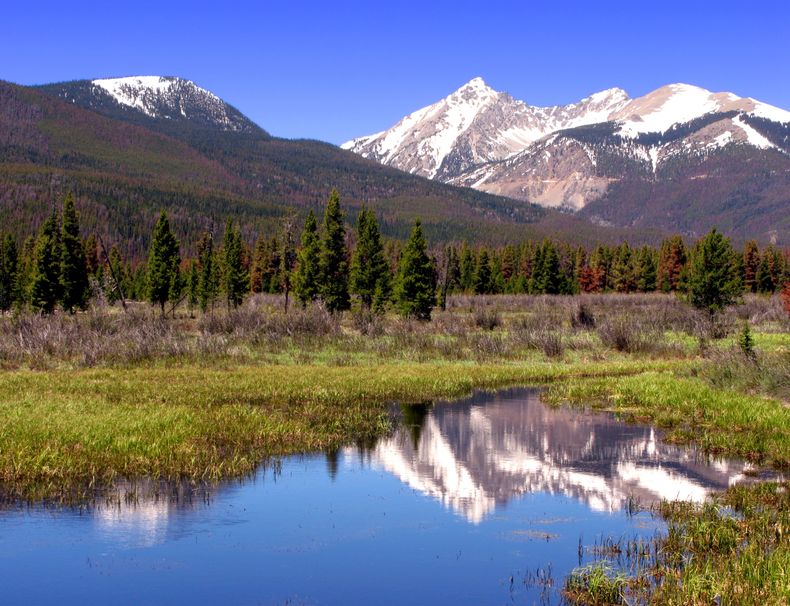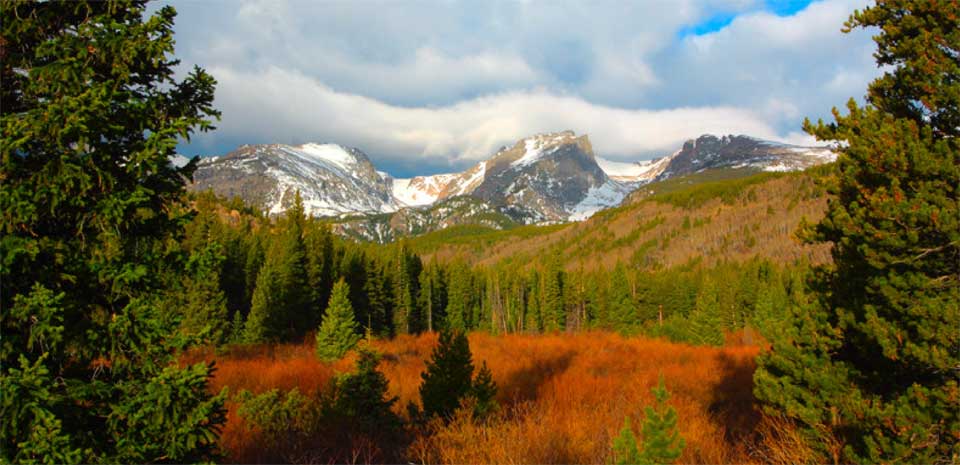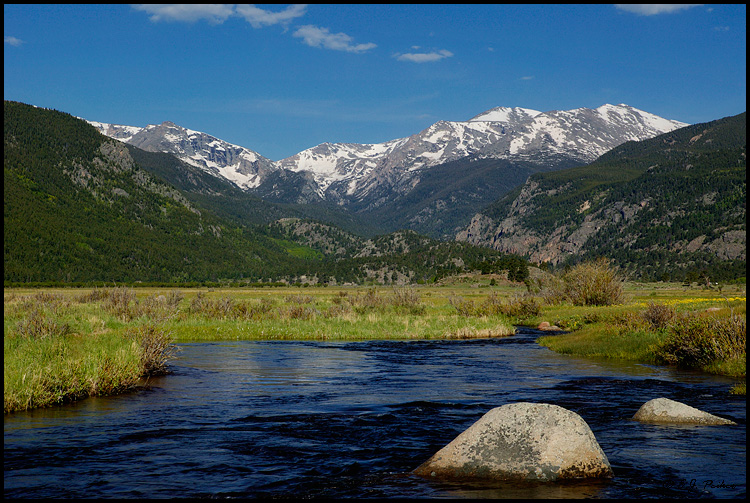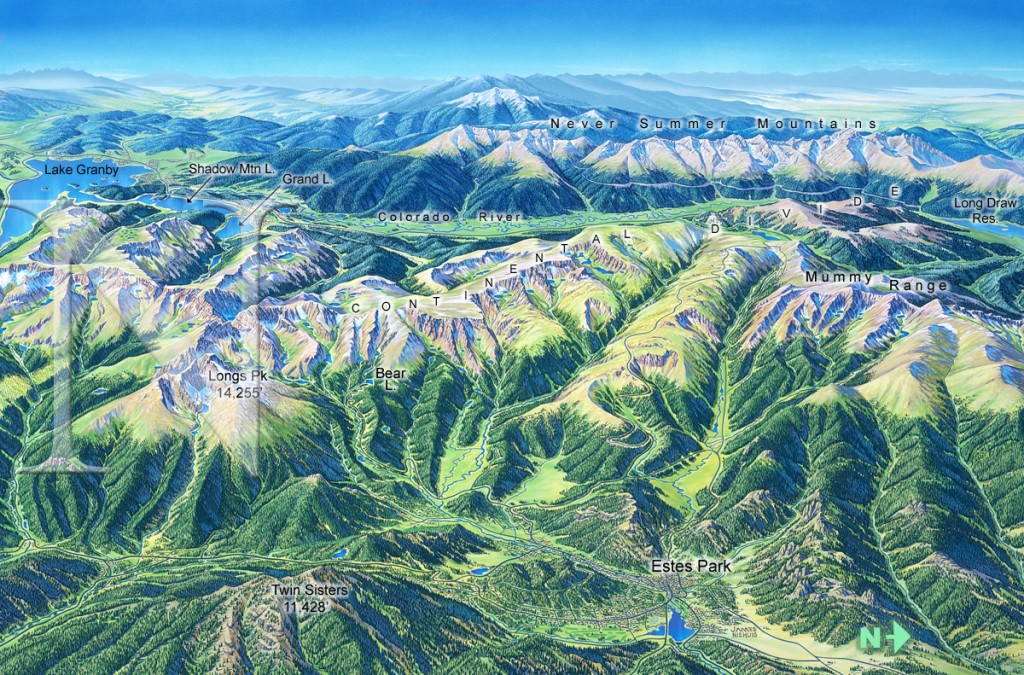
Rocky Mountain National Park
Established in 1915
Rocky Mountain National Park’s 415 square miles encompass and protect spectacular mountain environments. Enjoy Trail Ridge Road – which crests over 12,000 feet including many overlooks to experience the subalpine and alpine worlds – Rocky Mountain National Park encompasses approximately 265,770 acres of land in Colorado’s northern Front Range. The park is split by the Continental Divide, which gives the eastern and western portions of the park a different character. The east side of the park tends to be dryer, with heavily glaciated peaks and cirques. The west side of the park is wetter and more lush, with deep forests dominating.
The park contains 359 miles of trails, 150 lakes, and 450 miles of streams. The park contains over 60 named peaks higher than 12,000 feet, and over one fourth of the park resides above treeline. The highest point of the park is Longs Peak, which rises to 14,259 feet (surveys before 2002 show 14,255 feet [2]) above sea level. Longs Peak is the only fourteen thousand foot peak in the park.
The park is located north-west of Boulder, Colorado in the Colorado Rockies, and includes the Continental Divide and the headwaters of the Colorado River in its land area. The park has five visitor centers. The park headquarters, Beaver Meadows Visitor Center, is a National Historic Landmark, designed by the Frank Lloyd Wright.
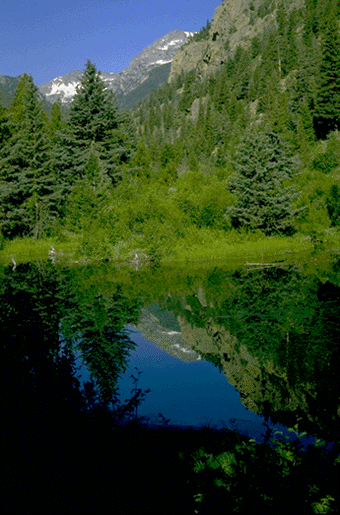 Scenic Drives
Scenic Drives
The road system of Rocky Mountain National Park offers visitors access to diverse ecosystems characterizing the higher regions of the central Rocky Mountains. The roads take visitors through lowland meadows and aspen groves, along swift-flowing rivers and up through subalpine forests to more than 12,000 feet in elevation. No other national park roads offer the dramatic experience of a long drive across alpine tundra region, and few offer such a wide variety of experiences.
The careful relationship of the park roads to the landscape results in a road system that generally harmonizes with the environment. Roadway alignments were chosen to highlight natural features, and scenic vistas and overlooks were provided to allow visitors to take in the magnificent terrain. The stone parapet walls and road-related structures, constructed in the National Park Service’s distinctive rustic style of architecture, relate well to their natural surroundings and help evoke a distinctive experience. Not surprisingly, the park roads are the principal attraction for most of the nearly three million visitors who flock to Rocky Mountain National Park each year.
scenic drives includes:
- Trail Ridge Road: http://www.nps.gov/romo/planyourvisit/trail_ridge_road.htm
- Old Fall River Road: http://www.nps.gov/romo/planyourvisit/old_fall_river_road.htm
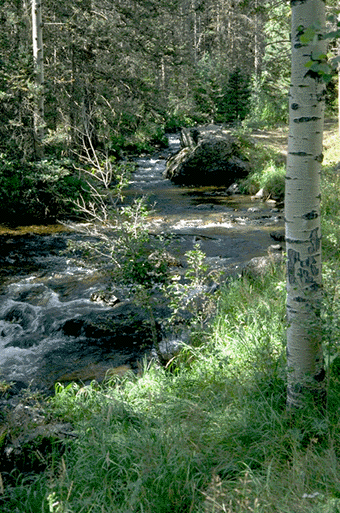 Campgrounds
Campgrounds
There are five drive-in campgrounds and one drive-in group camping area in the park. Two campgrounds, Moraine Park and Glacier Basin, take reservations, as does the group-camping area. Other park campgrounds are first-come, first-served, and fill on most summer days. There are no electric, water or sewer hookups at any camp sites. The water is turned off in the winter at all year-round campgrounds. Drinking water is available at entrance stations and open visitor centers.
Campground sites
- Aspenglen Campground (8200 ft)-54 sites. Open from mid-May to September
- Glacier Basin Campground (8500 ft)-150 sites. Open from late May to September
- Glacier Basin Group Sites – Open from late May to September. Tents only.
- Longs Peak Campground (9405 ft)-26 sites. Open year round. Tents only.
- Moraine Park Campground (8160 ft)-245 sites. Open year round.
- Timber Creek Campground (8900 ft)- 98 sites. Open year round.
Reservations recommended.
Climbing and Mountaineering
Climbing has been a popular activity in and around the area since the 1800’s. The wide variety of peaks and granite rock formations in the Park provide excellent opportunities for a wide spectrum of climbing including rock, big wall, snow and ice, bouldering and mountaineering. It is a mecca for local climbers, as well as those from around the world. Opportunities for climbing exist in many areas of the park including Lumpy Ridge and Longs Peak. Whichever activity you select, it is your responsibility to respect the areas you visit, minimize your impacts, and know and obey all park regulations.
- climbing information: http://www.nps.gov/romo/planyourvisit/climbing.htm
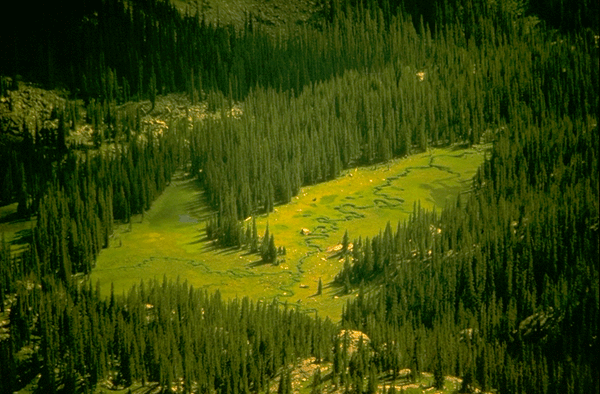
Hiking
The Park has 355 miles of hiking trails. They range from flat lakeside strolls to steep mountain peak climbs. If you are new to the park consult with rangers at the visitor centers and backcountry office. They can provide advice about trails which are appropriate to different fitness and experience levels.
As you plan your hike, keep in mind that park elevations range from 7,500 to over 12,000 feet. Even very fit individuals coming from lower elevations may experience altitude problems. Symptoms include headaches, shortness of breath, insomnia and rapid heartbeat. After a few days your body will have made some physiological adjustments to higher elevations, but full acclimation may take weeks. To minimize symptoms drink plenty of fluids, avoid alcohol, don’t skip meals and get plenty of rest.
Although you may not feel thirsty, the “thinner” air at high elevations actually results in increased water evaporation from your lungs. Again, drinking extra water may prevent a bad headache or other altitude symptoms.
Ultraviolet light is stronger in the mountains because there is less atmosphere for the sunlight to pass through. Wear sunscreen, a hat, sun glasses and consider wearing a long sleeved shirt if you are out in the sun for an extended period.
If you have never hiked before or are traveling with children, check out the recommended accessible trails. Ranger-led walks are free and can increase your confidence while you learn more about the park. Rocky Mountain National Park is a great place to discover how traveling by foot brings you closer to nature.
Biking
In the Summer, Bicycles are allowed on park roads only. Be aware park roads have narrow or no shoulders, and often carry heavy traffic. To minimize conflicts with vehicles, plan your ride for the early morning hours. Try to be off the road in late afternoon when thunderstorms and lightening create serious hazards. Old Fall River Road (gravel surface) and Trail Ridge Road (paved) are open to bicycles early in the summer season (April), before they open to vehicles. In Winter roads open to bicycles are Upper Beaver Meadows Road, Moraine Park Campground (closed loops), Endovalley Road, Aspenglen Campground and High Drive
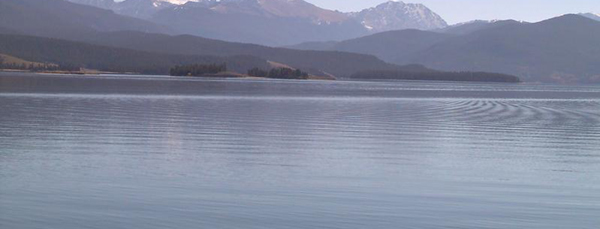
Fishing
Fishing was popular with early settlers and visitors in the Rocky Mountains. In an attempt to improve the sport, many streams and lakes were stocked with non-native species of trout. Waters with no sport fish were also stocked. The National Park Service stocked non-native Yellowstone cutthroat trout as late as 1969. The only trout native to the park are the greenback cutthroat and the Colorado River cutthroat. These efforts to enhance recreational opportunities in National Park areas were reconsidered in the 1970’s. Since 1975, native greenback cutthroat and Colorado River cutthroat trout are being restored to park waters and exotic or non-native fish are being removed. Today’s Populations of at least four species of trout exist in the park: brown, brook, rainbow, and cutthroat. Some suckers also inhabit the streams and lakes. Only 48 of the 156 lakes in the park have reproducing populations of fish. Cold water temperatures and lack of spawning habitat prevent reproduction in high altitude lakes. Supplemental stocking is done only to restore native species. Fishing success at high altitudes varies, even in waters known to contain fish. Restoration of native species requires that the possession limits be managed carefully. See posession limit below for specific regulations. You must be able to identify each species of fish taken. Colorado fishing license required for persons 16 years of age or older
Kids’ Activities
Infants can be carried in a front pack, which can be tucked inside the jacket if it’s chilly. Hike anywhere. The youngster will be enthralled by the stunning scenery and the fresh mountain air, so enthralled that he or she will fall asleep in short order.
When they reach the toddler stage, children begin to more actively interact with nature. It is a time of observation, of making initial connections and stockpiling notes. It is a wonderful time to introduce them to one of the many discovery trips found around the park. A few suggestions.
Explore the edges of Bear Lake while enjoying the guidebook-guided trail tour that explains the area’s natural and human history. Water holds an amazing variety of plant and animal life that will pique a child’s curiosity.
Discover Rocky Mountain’s amazing array of wildlife. At particular times during the summer (ask a park ranger), the bighorn sheep come down to Sheep Lakes.
Kids especially enjoy watching them cross the road after the lambs are born. Find a ponderosa pine forest and watch for Abert’s squirrels. Their dark color and busy activities catch a toddler’s eye for contrast and movement.
Kids that are a bit older develop a more complex understanding of the world around them. While some children might enjoy expending energy hiking along a trail, most seem happiest thoroughly exploring a smaller area. On any hike with 3 to 5 year olds, it’s a good idea to include a magnifying glass in the backpack. Textures of trees, plants, bugs and rocks are exciting close-up.
Kids love climbing on rocks. The trail to Gem Lake is a rocky paradise lined by boulders that are perfectly arranged for climbing.
In the early summer, enjoy the amazing floral colors found along the trail to Cub Lake. Have the youngsters keep an eye out for hummingbirds that may be visiting the flowers. Watch for beaver along the way in the Cub Creek drainage. Beaver dams are easy to spot in this area and stream banks are ideal places to look for animal tracks.
- The park has a “Rocky’s Junior Ranger Program” for children in kindergarten through eighth grade. Emphasis is placed on park preservation, flora and fauna facts, and environmental education. When kids complete the Junior Ranger booklet, they earn a badge. Check at a visitor center for information.
- “Children’s Adventure” is a ranger-led program for kids 6 to 12 years old. It focuses on hands-on activities that teach kids about the park’s geology and wildlife. At the “Skins and Skulls” talk, kids touch animal skulls and stuffed animals while learning about moose, elk, bighorn sheep, bobcats, and other creatures.
- “Rocky’s Engineers” is a terrific program led by a park ranger. Kids and adults learn how beavers make the harsh Rocky Mountain environment their home. Bring your Junior Ranger Log Book to earn credit for attending. Check at a visitor center for times.
- Explore the park at night by attending “Rocky After Dark,” led by a ranger. The whole family will learn about animals that see well in the dark, plus how to identify trees by touch. Bring jackets and flashlights.
- The Beaver Boardwalk near the beginning of Trail Ridge Road is another place to visit with young beaver fans. The trail takes you over a pond recently inhabited by an industrious colony of beavers. Their story is told on signs along the walkway.
- There are plenty of hiking trails that kids can enjoy (a half mile or less). See what plants and animals they can identify on the trail. The Moraine Park Nature Trail tests observation skills. Scout the shores of alpine lakes on Sprague Lake Nature Trail and Bear Lake Trail.
- Saddle up a horse and ride into the high country. This is a wonderful way for older children to see more alpine country than possible on foot. Sign up for one of the guided rides that allow time for fishing for brown, brook, rainbow, and cutthroat trout. (A state fishing license is required.) Call 970.586.3244 or 970.586.2327.
- Try this car game: Describe what the mountains, clouds, and other features look like. The Mummy Range, for example, looks like a sleeping Egyptian mummy. What other shapes do the mountains seem to take?
- At the Moraine Park Museum, see exhibits designed especially with kids in mind. The “animal, vegetable, mineral” game is a natural to play after learning about the geology and wildlife of the Rockies. For example: “I’m thinking of something that’s speckled when it’s warm out and white when it snows.” (A ptarmigan.)
- In late July, the mountains ring with music and fun during the Rooftop Fair and Rodeo in Estes Park. A rodeo with Colorado cowboys, a parade, and country-western concerts are all on the agenda. In the winter, go to the Winter Carnival at Grand Lake to celebrate this snowy wonderland. There are snowmobile events, snow sculpture contests, and more.
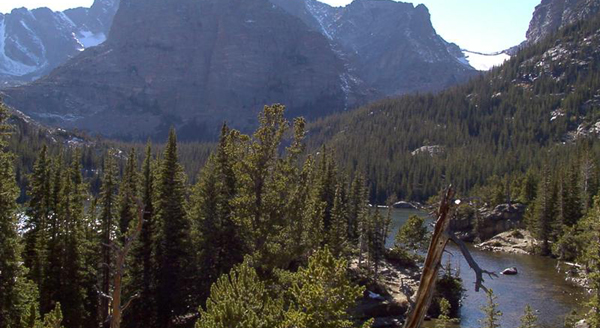
Wildlife Viewing
Visitors viewing wild animals, especially the big ones. With an elk herd numbering more than 3,000, about 800 bighorn sheep, numerous mule deer and a small population of moose calling the park home, it’s no surprise that wildlife watching is rated the number-one activity by a vast majority of Rocky’s three million annual visitors.
The park’s great large-animal population makes it one of the country’s top wildlife watching destinations. But there is much more to see than these so-called “charismatic megafauna.” Also found are nearly 60 other species of mammals; more than 280 recorded bird species; six amphibians, including the federally endangered boreal toad; one reptile (the harmless garter snake); 11 species of fish; and countless insects, including a surprisingly large number of butterflies.
Some basic knowledge of animal habits and habitats greatly enhances prospects of spotting Rocky Mountain’s wild residents. A few park favorites:
- Elk can be seen anytime, a popular viewing period being the fall rut, or mating season. Look for elk in meadows and where meadow and forest meet. Elk spend much of their time at or above treeline during the summer, moving to lower elevations in the fall, winter and spring. Favorite feeding times: dawn and dusk.
- Bighorn sheep are commonly seen at Sheep Lakes from May through mid-August.
- Moose frequent willow thickets along the Colorado River in the Kawuneeche Valley on the park’s west side.
- Otters were reintroduced into the Colorado River area and are doing fairly well. These animals are difficult to spot.
- Mule deer are common and can be seen anywhere. They are most often found at lower elevations in open areas.
- Bats feed over lakes and ponds at dawn and dusk.
- Marmots and pikas favor rocky areas. Marmots are best seen on the alpine tundra along Trail Ridge and Old Fall River roads. Pikas – small, light-colored mammals – are common in rock piles. Listen for their sharp, distinctive bark and watch for movement.
- Clark’s nutcrackers, Steller’s jays, golden eagles and prairie falcons can be seen along Trail Ridge Road.
- White-tailed ptarmigans, some of the most sought-after birds in Rocky Mountain National Park, are common but difficult to spot. For best results, hike on the tundra and look carefully. Ptarmigans usually remain still, relying on their natural camouflage for protection.
- American dippers, or water ouzels, can be found along most streams. Listen for their loud call, similar to the rapid clicking of two stones together, as they fly up and down their territories.
Despite their good intentions, some wildlife watchers are loving park animals to death. Feeding junk food to wildlife reduces its ability to survive the long mountain winter. When they panhandle by roadsides, animals fall easy prey to automobiles. As they become habituated to humans and lose their natural fear, the animals become aggressive and may be destroyed. Harassing or feeding wildlife is illegal in all national parks.
Tips For Successful, Enjoyable Wildlife Watching
Watch from a distance. Use binoculars or a telephoto lens to get close-up views. Following larger animals too closely to get a photograph or a better look can stress them and threaten their health. If animals notice you or if they seem nervous, you are too close. Move away quietly.
- Obey all signs posting closed areas. At different times of the year, some park areas are closed to protect wildlife during nesting, mating and birthing seasons.
- Keep pets in your vehicle. Pets may scare wildlife, and wild animals can hurt the pet.
- Use of wildlife calls and spotlights is illegal. They stress animals and alter their natural behavior.
- Some large animals such as elk, sheep, bears and mountain lions are dangerous. Check at visitor centers for tips on safety around wildlife.
- Drive slowly. Watch for animals crossing the road. Deer and elk are seldom alone. If you see one animal, look for others that may follow.
- Stop your car to watch animals only if you can pull off the road safely. Do not block traffic.
- When possible, get away from roadsides and sit quietly to observe and listen for wildlife. Talk only when necessary, and do so quietly so you don’t disturb the animals or other wildlife watchers. If viewing wild animals from your vehicle, turn off the motor.
Park Ranger leads many interpretive programs offered to visitors.
Links
Rocky Mountain National Park: http://www.nps.gov/romo

